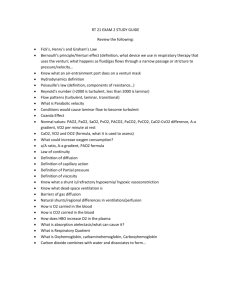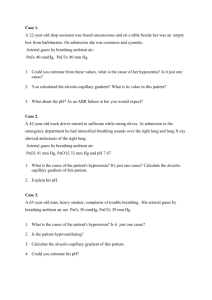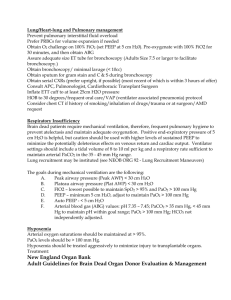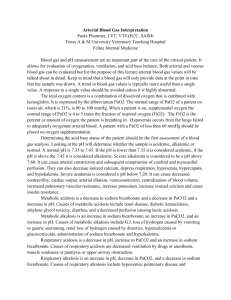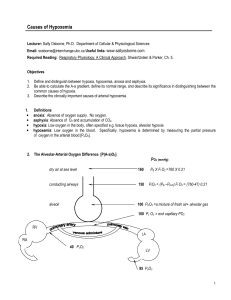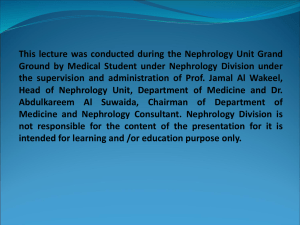ABG Analysis in Hypoxemia: A Differential Diagnosis Approach
advertisement
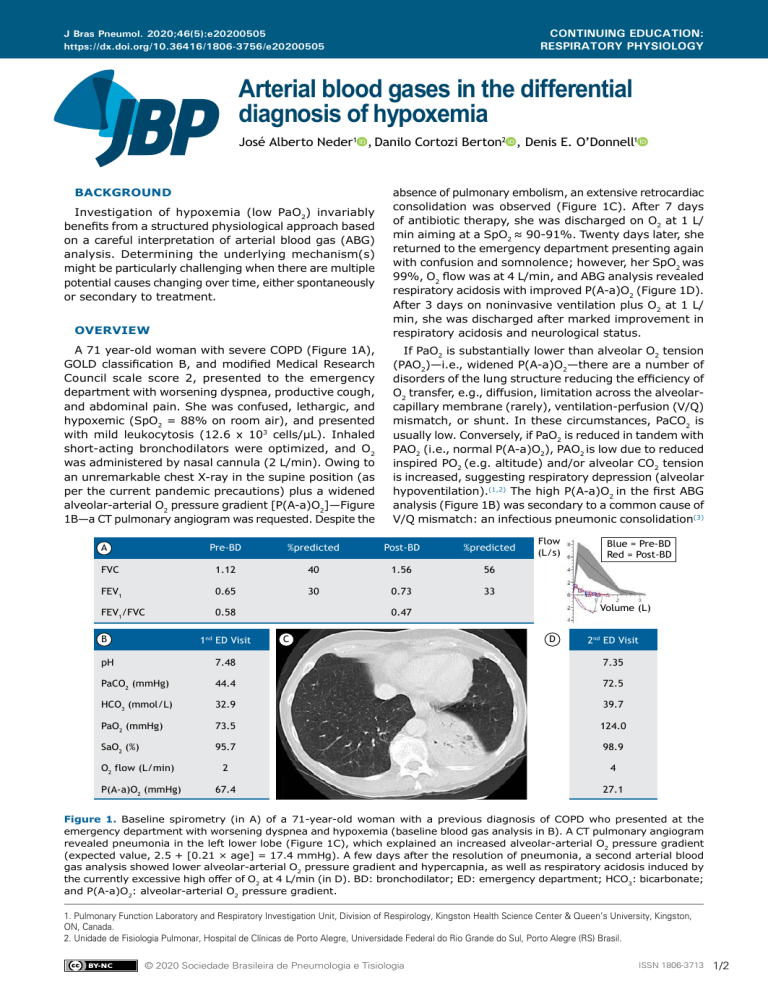
CONTINUING EDUCATION: RESPIRATORY PHYSIOLOGY J Bras Pneumol. 2020;46(5):e20200505 https://dx.doi.org/10.36416/1806-3756/e20200505 Arterial blood gases in the differential diagnosis of hypoxemia José Alberto Neder1a, Danilo Cortozi Berton2a, Denis E. O’Donnell1a BACKGROUND Investigation of hypoxemia (low PaO2) invariably benefits from a structured physiological approach based on a careful interpretation of arterial blood gas (ABG) analysis. Determining the underlying mechanism(s) might be particularly challenging when there are multiple potential causes changing over time, either spontaneously or secondary to treatment. OVERVIEW A 71 year-old woman with severe COPD (Figure 1A), GOLD classification B, and modified Medical Research Council scale score 2, presented to the emergency department with worsening dyspnea, productive cough, and abdominal pain. She was confused, lethargic, and hypoxemic (SpO2 = 88% on room air), and presented with mild leukocytosis (12.6 x 103 cells/µL). Inhaled short-acting bronchodilators were optimized, and O2 was administered by nasal cannula (2 L/min). Owing to an unremarkable chest X-ray in the supine position (as per the current pandemic precautions) plus a widened alveolar-arterial O2 pressure gradient [P(A-a)O2]—Figure 1B—a CT pulmonary angiogram was requested. Despite the absence of pulmonary embolism, an extensive retrocardiac consolidation was observed (Figure 1C). After 7 days of antibiotic therapy, she was discharged on O2 at 1 L/ min aiming at a SpO2 ≈ 90-91%. Twenty days later, she returned to the emergency department presenting again with confusion and somnolence; however, her SpO2 was 99%, O2 flow was at 4 L/min, and ABG analysis revealed respiratory acidosis with improved P(A-a)O2 (Figure 1D). After 3 days on noninvasive ventilation plus O2 at 1 L/ min, she was discharged after marked improvement in respiratory acidosis and neurological status. If PaO2 is substantially lower than alveolar O2 tension (PAO2)—i.e., widened P(A-a)O2—there are a number of disorders of the lung structure reducing the efficiency of O2 transfer, e.g., diffusion, limitation across the alveolarcapillary membrane (rarely), ventilation-perfusion (V/Q) mismatch, or shunt. In these circumstances, PaCO2 is usually low. Conversely, if PaO2 is reduced in tandem with PAO2 (i.e., normal P(A-a)O2), PAO2 is low due to reduced inspired PO2 (e.g. altitude) and/or alveolar CO2 tension is increased, suggesting respiratory depression (alveolar hypoventilation).(1,2) The high P(A-a)O2 in the first ABG analysis (Figure 1B) was secondary to a common cause of V/Q mismatch: an infectious pneumonic consolidation(3) Pre-BD %predicted Post-BD %predicted FVC 1.12 40 1.56 56 FEV1 0.65 30 0.73 33 FEV1/FVC 0.58 A B 1nd ED Visit Flow (L/s) Volume (L) 0.47 C Blue = Pre-BD Red = Post-BD D 2nd ED Visit pH 7.48 7.35 PaCO2 (mmHg) 44.4 72.5 HCO3 (mmol/L) 32.9 39.7 PaO2 (mmHg) 73.5 124.0 SaO2 (%) 95.7 98.9 2 4 67.4 27.1 O2 flow (L/min) P(A-a)O2 (mmHg) Figure 1. Baseline spirometry (in A) of a 71-year-old woman with a previous diagnosis of COPD who presented at the emergency department with worsening dyspnea and hypoxemia (baseline blood gas analysis in B). A CT pulmonary angiogram revealed pneumonia in the left lower lobe (Figure 1C), which explained an increased alveolar-arterial O2 pressure gradient (expected value, 2.5 + [0.21 × age] = 17.4 mmHg). A few days after the resolution of pneumonia, a second arterial blood gas analysis showed lower alveolar-arterial O2 pressure gradient and hypercapnia, as well as respiratory acidosis induced by the currently excessive high offer of O2 at 4 L/min (in D). BD: bronchodilator; ED: emergency department; HCO3: bicarbonate; and P(A-a)O2: alveolar-arterial O2 pressure gradient. 1. Pulmonary Function Laboratory and Respiratory Investigation Unit, Division of Respirology, Kingston Health Science Center & Queen’s University, Kingston, ON, Canada. 2. Unidade de Fisiologia Pulmonar, Hospital de Clínicas de Porto Alegre, Universidade Federal do Rio Grande do Sul, Porto Alegre (RS) Brasil. © 2020 Sociedade Brasileira de Pneumologia e Tisiologia ISSN 1806-3713 1/2 Arterial blood gases in the differential diagnosis of hypoxemia (Figure 1C); in fact, the patient’s hypoxemia responded well to a relatively low FiO2, which is not consistent with shunt. ABG analysis also revealed increased bicarbonate levels: when a patient with chronic hypercapnia and showing compensatory bicarbonate accumulation is exposed to a source of a high ventilatory drive (e.g. hypoxemia), PaCO2 may drop down to the normal range; thus, metabolic alkalosis may emerge (Figure 1B).(1) The second ABG analysis showed a different scenario (Figure 1D): at that point in time, the extra source of V/Q mismatch was no longer present, i.e., pneumonia had been resolved. Consequentially, excessively high inspired O2 flows for the improved P(A-a)O2 increased O2 tension in the alveoli, causing low level of ventilation and inhibiting hypoxic pulmonary vasoconstriction, a well-known cause of hypercapnia (Figure 1D).(4,5) CLINICAL MESSAGE Interpretation of ABG analysis in a hypoxemic patient should consider the clinical history, ongoing treatment, and recent/current inspired O2 flows. The information provided by P(A-a)O2 should be considered in association with PaCO2 (and pH). A normal P(A-a) O2 in the presence of hypoxemia signals reduced ambient oxygen or alveolar hypoventilation, shown by elevated PaCO2. REFERENCES 1. Williams AJ. ABC of oxygen: assessing and interpreting arterial blood gases and acid-base balance. BMJ. 1998;317(7167):1213-1216. https://doi.org/10.1136/bmj.317.7167.1213 2. Wagner PD. The physiological basis of pulmonary gas exchange: implications for clinical interpretation of arterial blood gases. Eur Respir J. 2015;45(1):227-243. https://doi.org/10.1183/09031936.00039214 3. Theodore AC. Measures of oxygenation and mechanisms of hypoxemia. In: UpToDate. Parsons PE, Finlay G, editors. Waltam MA; 2017 [cited 2020 Sep 15]. Available from: https://www. 2/2 J Bras Pneumol. 2020;46(5):e20200505 uptodate.com/contents/measures-of-oxygenation-and-mechanismsof-hypoxemia 4. Abdo WF, Heunks LM. Oxygen-induced hypercapnia in COPD: myths and facts. Crit Care. 2012;16(5):323. https://doi.org/10.1186/cc11475 5. Hanson CW 3rd, Marshall BE, Frasch HF, Marshall C. Causes of hypercarbia with oxygen therapy in patients with chronic obstructive pulmonary disease. Crit Care Med. 1996;24(1):23-28. https://doi. org/10.1097/00003246-199601000-00007
